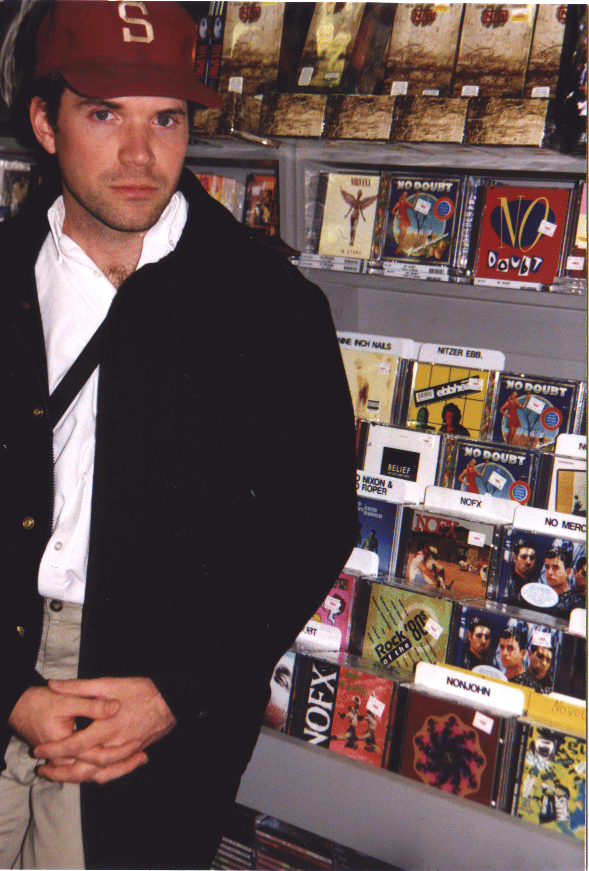
Nonjohn's Musical Philosophy and Autobiography
Copyright 2004
All Rights Reserved
Nonjohn at Tower Records, Mountain View, California, December 12, 1997

Tower Records was the first music retailer to carry "Nine Nons Jolt Him Not," the first album to use the "Nonjohn" name.
The Philosophy Behind My Music:
I am an "Integrative" Music Composer.
When I feel pressured by others to label myself with a single adjective to describe the function, role, or style of my music, depending on the situation, I usually say, "I am an eclectic music composer" or "I am a world music composer" or "I am a dance music composer" or "I am an integrative music composer." All four statements are true. However, the adjective "integrative" can subsume the three other adjectives. Yet, people often don't know what I mean by "integrative." Thus, I usually don't use it as a first choice in contexts where I don't have a chance or time to explain myself. Most often, people are simply fishing for one of their pre-existing cognitive categories in which to place me during the context of small talk. Since some don't know what the word, "eclectic" means, "dance" or "world" are truthful and seem to provide meaning for questions posed in the time-limited context of small talk.
However, if I had time to explain myself, and if I could only use a SINGLE adjective, I would probably say that I am an "integrative" music composer. Here, I use the word "integrative" to mean integrative across the space and time of different cultures and styles of music and its history. I also use the word "integrative" to mean integrative of different sensory and motor modalities within a human body that is experiencing music or "integrative" in the way music might bring two or more human bodies together in dance, relationship, or sexuality.
The Integrative Function of Dance Music
I find myself motivated to compose, record, and perform music that integrates different sensory or motor modalities. For example, if music could simultaneously be heard as sound, but at the same time activate the imagination or actual sensations in other modalities like sight, touch, smell, or taste, such music would be highly "integrative." Such music could be said to have a function of creating "Hyper-Synesthesia" (a blending of the senses, with the typical example of which would be "hearing colors"). Music can also cause an integration to occur between lower and higher brain functions. That is, music can appeal to the intellect by being "mathematically" beautiful, but at the same time, can have elements that make you want to move or dance to the music. What is called "dance" music seems to have the elements that give it the potential to most powerfully integrate sensory, motor, and intellectual modalities. Granted, not all "dance" music appeals to all of these modalities, but the potential exists for it to do so. Dance music always has the potential to serve a social or "integrative" function between people, even if that social role is of an audience viewing a solo dance performance. For as early as I can remember, music in my life has always been connected to a social context, and thus has always played an integrative role.
After high school, I studied compositional traditions in college that approached music more as an intellectual, cognitive exercise often yielding music devoid of any features that result in listeners wanting to move or dance to the music. Yet, I never found such music to be as satisfying as music that is simultaneously musically complex, lyrically sophisticated, intellectually deep, AND danceable. As I like to feel my mind and body move, I prefer to compose "dance" music over all other forms. However, I respect the need and validity of ALL forms of music.
However, if my body does not resonate with the music I compose or hear, such music has a harder time holding my attention. If I find that my body is starting to move spontaneously to music I hear, I know that such mush has tapped into something very basic and perhaps primitive in my brain. When playing percussion in a Samba batteria, I have had what can only be described as religious experiences similar to what I experience at the high school pep rally in the fall of 1985. Although all human beings are said to have evolved in Africa, what are currently known as African rhythms seem to tap into our primitive brains in a way that (if our intellect can let go) can invoke a deep, involuntary, yet satisfying bodily movement and resonance as strong as any I have ever experienced. Some call it "trance" dancing. To me, it is simply dancing in its most natural, uninhibited, and primitive form.
Consequently, if I could only compose and play and hear one "kind" of music, I would want it to have the elements that allowed it to be experienced as "dance" music. From the bluegrass hoedowns or Boogie Woogie of my youth to the electronica of my college and latter days, I am fundamentally a "dance" composer. Moreover, I do NOT use the word "dance" lightly or to suggest anything simple or superficial. Great dances CAN be simple. However, the dance form is as infinite as any other recognized musical "style" in its potential for complexity.
Since dancing is a way to connect socially, dance music is the musical form that allows for music to be the most universal language with which to bring people and nations together. Dance music has a more extensive history of evoking feelings of love than any other form of music. The capacity to evoke "love" should not be taken lightly. Such love can dissolve hatred and prevent wars between nations. Dance music can also serve a "soundtrack" for interpersonal psychological love and experiences, as well as for physical and sexual love. Indeed, the consummate act of sexual intercourse, the reason of which we are all alive today, is enhanced more by dance music than any other style of music.
There is no reason to be ashamed or embarrassed by the inextricable association between dance music and sex. The connection is evolutionarily and archetypically there whether prudish people want it to be there or not. As long as sex is regarded as being "respectable," dance music will also be "respectable." Some early jazz musicians have been made to feel uncomfortable by the association that early jazz, Boogie Woogie, and ragtime had with brothels and sex. Being made to feel apologetic by this connection is unfortunate, especially since it is not always clear whether sex inspired the creation of dance music, or whether dance music has inspired sexual behaviors. Like most things, influences have probably occurred in both directions.
In addition to the rhythms of dance music, I have come to love the complex improvised melodies and phrasing using Indian scales. Harmonically speaking, I am fully "experimental." Even though I will delve into dissonant harmonic combinations, I still love the feeling of having a highly-anticipated tonic resolution. The sense of resolution provided by the tonic is the melodic equivalent of orgasm. The tonic IS orgasm. However, like real orgasms, if you delay your musical orgasm (the occurrence of the tonic), the pleasure of the tonic will be all the more strong when you finally reach it.
The Integrative Function of Eclectic and World Music
The other sense of "integrative" that I mean is what is commonly implied by the words "eclectic" or "world." These words imply an integration of difference styles, cultures, or instrumentation across the space and time of musical history. Such a broad palette gives a composer the greatest possible chance of evolving, sometimes through a sort of natural-selection of trial-and-error, musical styles with more potential for "integration" in all senses of the word.
Nonjohn's Ancestors Become Texans
My Great Great Great Grandfather, Joshua Tennison (born in Georgia, January 8, 1817), moved from Georgia to Titus County (near Mount Pleasant), Texas in the late 1850s. Joshua's son (My Great Great Grandfather), James Booker Tennison, arrived with him. This placed the Tennison family squarely in the Piney Woods Region of East Texas close to the birthplace of Scott Joplin, and set the geographical stage by which Joplin's and other seminal music of the area would be able to influence the Tennison progeny. There is still a "Tennison Road" in Mount Pleasant that runs by the old Tennison farm in the Union Hill Community to the southeast of Mount Pleasant. There is also a "Tennison Memorial Church" in Mount Pleasant. The church is a Methodist church named in memory of James Morgan Tennison (the son of James Booker Tennison, and my great grandfather).
My father, Alfred Austin Tennison, Jr., is a poet and songwriter, and has worked as a D.J. at 4 different radio stations in the Texarkana area. Although he did not pursue a professional career as a writer, my father was voted "Class Poet" during his senior year of high school, 1954-55. His large record collection of bluegrass, old-time mountain gospel, and his and my mother's collection of early Rock and Roll had a substantial influence on me. My father also exposed me to live bluegrass festival music while I was in elementary school.
Nonjohn's Great Great Grandfather and Great Great Grandmother in Mt. Pleasant, Texas
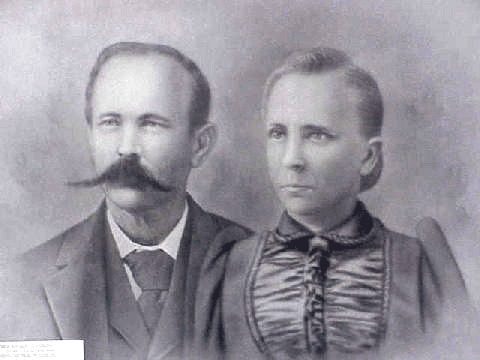
Pictured above is James Booker Tennison and Josephine Tabb Tennison, my Great Great Grandparents. I am not aware of an existing photo of Joshua Tennison, my Great Great Great Grandfather, but he is buried in Mount Pleasant, Texas.
Family Influences and Home Life - The Mighty Sound of Steam!
As the third of four children, I was also exposed to the musical activities of my siblings. The first-born sibling in my family, Alfred Tennison III (known as "Trip" as a contraction of "triple"), was and still is an excellent drummer. Trip excelled at drumming and was the "First Band, First Chair" drummer of the Arkansas All-state drumming competition. Although he could have easily gone on to become a professional percussionist, other priorities ultimately prevailed. I have no doubt that hearing Trip's excellent drumming technique helped the musical development of my own brain. My two other siblings -- older sister Mary and younger brother Joseph ("Joe") -- were also involved in music and marching band, but probably did not influence me to the degree that Trip did.
Because my maternal grandmother, Floye Tilmon, owned a 1918 6-foot Knabe grand piano, and because I had composed simple melodies on it from a young age, she encouraged me to begin taking piano lessons from Mr. Edward Walters, who was among the most-respected classically-trained piano teachers in the Texarkana area. Edward Walters trained at Boston's New England Conservatory. He was born in 1912 and died in 1992. As of 2004, his surviving wife, Dorothy Walters (who also trained at the New England Conservatory and was also born in 1912) still lives on Olive Street in Texarkana, Texas, in the same house where Edward and she taught piano lessons. Another respected Texarkana piano teacher was Ms. Wood, who was the piano teacher of my boyhood friend, Michael Benson. Of all the people who graduated in my Texarkana Arkansas class of 1986, Michael was the most gifted pianist. In addition to his impeccable classical chops, Michael and his father, John Benson, were excellent Boogie Woogie players. The most complex live Boogie Woogies that I heard during elementary school were unquestionably those that I heard John Benson play. However, during elementary school music classes, my music teacher, Ms. Gilbert, would allow Michael and me to perform. Michael would play Boogie Woogie on the piano and I would scat sing along with the Boogie Woogie. At other times, Ms. Gilbert would allow me to perform simple songs that I had composed for the piano. Michael Benson went on to study piano performance at the Shepherd School of Music at Rice University and The University of Texas at Austin.
While I was attending North Heights Junior High School, my father introduced me to Lee Ree Sullivan, an African-American Boogie Woogie player who lived in Texarkana, Arkansas in the Iron Mountain District. For the next several years, Lee Ree Sullivan became my most important mentor of Boogie Woogie in Texarkana for the next several years. I learned more about Boogie Woogie from Lee Ree Sullivan than from any other person in Texarkana.
My father's two first cousins also had an important influence in helping to encourage and inspire me. One of these cousins was John Eargle, who earned his musical degree from the Eastman School of Music. John has also served as President of the Audio Engineering Society of America. John is known and respected throughout the world for his excellent recording and sound engineering technique. John is also an excellent pianist and organist in his own right. Interestingly, when I studied music and the Peabody Conservatory in Baltimore, John was one of my visiting professors.
My father's other first cousin, James Tennison, (now deceased) was an actor and movie critic in the Texarkana area. James encouraged my acting and musical performance from a young age.
The earliest "style" of music that I can remember hearing was the bluegrass and old-time country gospel that my father played loudly at my boyhood home in Texarkana, Arkansas. My younger brother, Joseph (Joe), and I would jump on our beds to the rhythm of the bluegrass music. I can also remember some early popular, highly-tonal classical music pieces to which I would jump. Thus, jumping to the music was my first memory of dancing. Because the jumping occurred in the context of music that my father was playing, it was a way that I socially connected with my father, and thus was integrative.
I can remember dancing to the chugging sound made by the first electric train set I had as a boy. The train set was a Lionel "Silver Star" set. Lionel had introduced the "Silver Star" train set in 1971. This set was a milestone in Lionel's history in that it marked their introduction of what Lionel called, "The Mighty Sound of Steam." There was a speaker in the coal tender car that emitted chugging sounds that were in perfect sync with movement of the side bars as they moved in and out of the cyllinders. The locomotive was a Pennsylvania 8141 "2-4-2" steam locomotive. I was mesmerized by watching the moving parts of the locomotive "dance" to the chugging sound. Consequently, I was inspired to dance in sync with the train and its chugging sound. Even though Lionel had not intended "The Mighty Sound of Steam" to function as a musical instrument, I had nonetheless experienced it as one. Moreover, the train transformer, a blue box with a silver lever, allowed me to control the speed of the train, and thus, the tempo of the chugging sound. Thus, my "Silver Star" train set functioned as my first "synthesizer," "drum machine," and "sequencer." Even now, I am entranced and feel a flood of positive emotions as I watch my Silver Star train dance along the track after I move the silver lever on the blue transformer. Interestingly, the track configuration that came with the Silver Star set was a figure-8, a shape that, after many hours of starring at my running train as a child, was indelibly etched in my consciousness. Because this shape, the lemniscate, is used to represent the concept of infinity, I am appreciative to Lionel for having caused this shape to have made an early impression on me. The concept of infinity subsequently became one of the loves of my life.
From these early instances of jumping to music, dancing with my first electric train, skating at the disco mirrored-ball skating rinks of the late 1970s, being a Drum Major at North Heights Junior High marching band during my 9th grade year, or participating in football pep rallies during high school, I grew accustomed to music that made me want to move. This movement allowed for music to be a whole-body, spine-tingling experience.
My first public performances of my own compositions occurred at St. James Day School, a private, Episcopalian school in Texarkana, Texas. My music teacher at St. James, Ms. Dixie Gilbert, encouraged me to perform my original piano compositions during music classes. During these same classes, I also performed with classmate, Michael Benson would play Boogie Woogie while I would scat sing.
St. James Day School in Texarkana, Texas
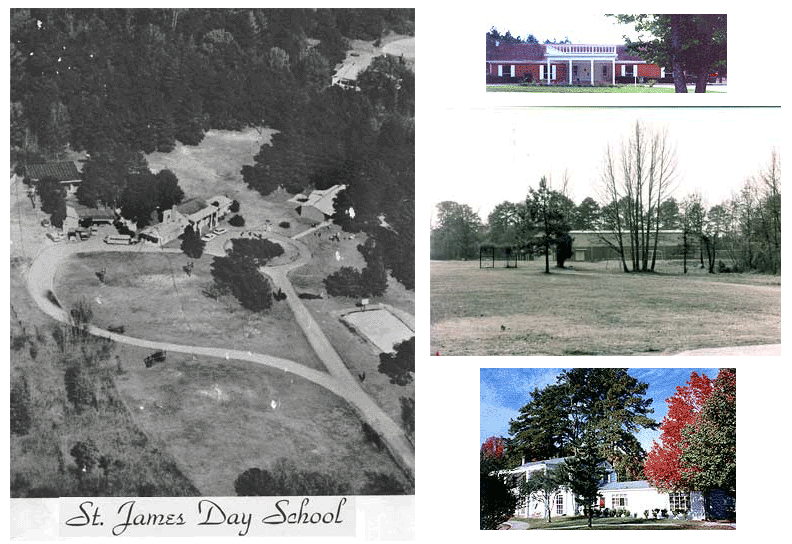
The above photos depict buildings where my first public performances of original music and other performances occurred. I was enrolled at St. James Day School from grades 1 through 6. The black and white aerial photo to the left is from 1954. Although it was taken before I enrolled at St. James, it depicts the early layout of the campus, and reveals the Piney Woods in which St. James was nestled and which are characteristic of Northeast Texas and which captured my imagination. The top color photo on the right housed classrooms for grades 1-3 while I was at St. James. The cafeteria in this building was also used for evening student productions. In this cafeteria, I performed on the electric piano and sang in student productions directed by my music teacher, Ms. Dixie Gilbert. I also performed magic shows in this building with both my younger brother, Joe, and my elementary school friend, Vickers Fuqua. The black and white photo in the middle right is the St. James Gym. During my 4th grade year at a student production in this gym, I performed Milk Buck Boogie (a piece written by Reece Shipley and made popular by Red Foley.) In the color photo on the lower right is the main administration building at St. James. It was in this building that I first performed my original piano compositions and scat sang to the Boogie Woogie played by classmate, Michael Benson. This same building can be seen with its columns facing the circular drive in the aerial photo to the left.
Nonjohn Performs "Milk Bucket Boogie" at St. James Day School While in the 4th Grade
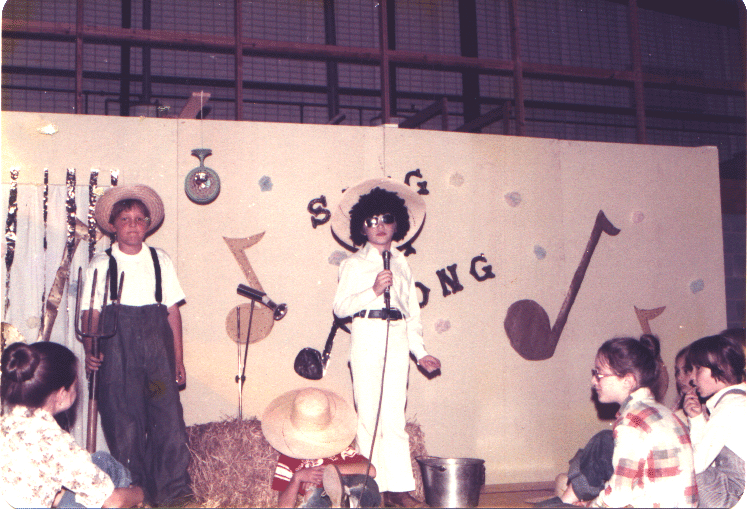
Check out that afro, sunglasses, and soulful outfit! If I could have naturally grown an afro, I would have done so! However, my hair is too fine. This performance was based on Red Foley's Decca 45 rpm LP of "Milk Bucket Boogie."
Classmate Michael Benson performs "Great Balls of Fire"
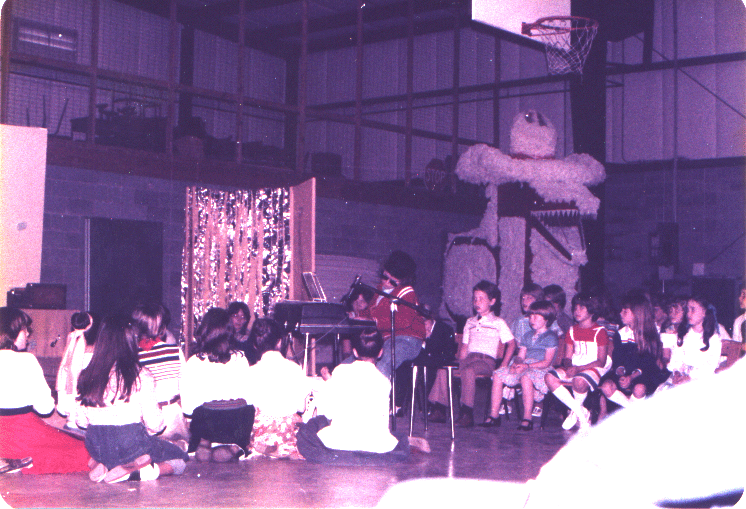
Michael Benson, my elementary school classmate, performs "Great Balls of Fire" with a Jerry Lee Lewis flare. Michael and his father, John Benson, both played Boogie Woogie, and provided some of the early live Boogie Woogie performances to which I was exposed and which caused me to want to learn to play Boogie Woogie.
My Exposure to Bluegrass, Boogie Woogie, and Scott Joplin's Ragtime Music
Having grown up in Texarkana, I was exposed to Bluegrass, Boogie Woogie, and the Ragtime music of The Father of Ragtime, Scott Joplin. Evidence suggests that Joplin was born somewhere between Texarkana and Marshall, Texas, possibly near Linden, Texas. The earliest qualifiable "styles" of music to which I was repetitively exposed were Bluegrass and old time country gospel music played loudly by my father in what he called "the radio room" at my boyhood home at 2003 County Avenue in Texarkana, Arkansas. My younger brother, Joe, and I would enter trance states while jumping on our beds while the Bluegrass music played. At one time I jumped so vigorously that I jumped into and broke the glass of the glass-paned window doors between Joe's and my room and the "radio room." This even pointed to the need for safety during trance states and other times where one intentionally dissociates from the monitoring the external environment.
My earliest exposure to Boogie Woogie came from listening to 1950s Rock and Roll music by Jerry Lee Lewis and Little Richard; by the live playing of classmate Michael Benson and his father, John Benson, who played their own variants of Clarence "Pine Top" Smith's Boogie Woogie; and from listening to records of Conlon Nancarrow's Boogie Woogie Suite that had been lent to me by my piano teacher, Edward Walters. There were also various other people who played Boogie Woogie around me while I was growing up in Texarkana. In fact, the playing of Boogie Woogie was probably the stylistic cliché that music store salesmen heard the most when customers were sampling keyboards at Lovall Music, the largest music equipment retailer in Texarkana when I was growing up. This is evidence to the fact that a Boogie Woogie sensibility was on the mind's of many young aspiring pianists. The Boogie Woogie style was socially empowering for boys. As had been the case for many years before, Boogie Woogie was a way to impress the girls.
Given my interest in Boogie Woogie piano, in the early 1980s, my father introduced me to a dear friend, Lee Ree Sullivan, an African-American Boogie Woogie player who lived in the Iron Mountain District of Texarkana, Arkansas. Lee Ree Sullivan had worked for Tennison Brothers, my family's Sheet-metal manufacturing business years before. I continued meeting with Lee Ree Sullivan every few months at my maternal grandmother's house. In each of these visits, Lee Ree shared his approach to playing Boogie Woogie on my Grandmother's Knabe Grand piano. In doing so, Lee Ree became my first African-American mentor of Boogie Woogie, and my most important Boogie Woogie mentor in Texarkana. Before going to college at Johns Hopkins in Baltimore, MD, in 1986, I interviewed Lee Ree Sullivan about the history of Boogie Woogie, part of the contents of which can be found in my website pertaining to the history of Boogie Woogie, at www.bowofo.org.
My exposure to Scott Joplin's Ragtime music occurred for similar reasons to my exposure to Boogie Woogie. That is, I heard various people around me playing the music of Scott Joplin when I was growing up. Moreover, the movie, "The Sting," also created a renaissance of playing and pride felt in Texarkana for Scott Joplin. Also, a large mural dedicated to Scott Joplin in downtown Texarkana evoked a constant curiosity and attention to the music of Scott Joplin.
Musical Development While Attending North Heights Junior High school
During grades 7 through 9, I was in band at North Heights Junior High School. I served as a drum major in the marching band during my 9th grade year. From 7th grade through high school, I played baritone in band. Although I excelled at the baritone (becoming "1st Band, 1st Chair" at the Henderson State University Band Camp), I never found playing the baritone as satisfying as other instruments that I learned and continue to play, such as drums, guitar, and keyboards.
Nonjohn and Classmate Bobby Ray Serve as Drum Majors and are All-Region Band Award Recipients
During Their 9th Grade Year at North Heights Junior High School in Texarkana, Arkansas
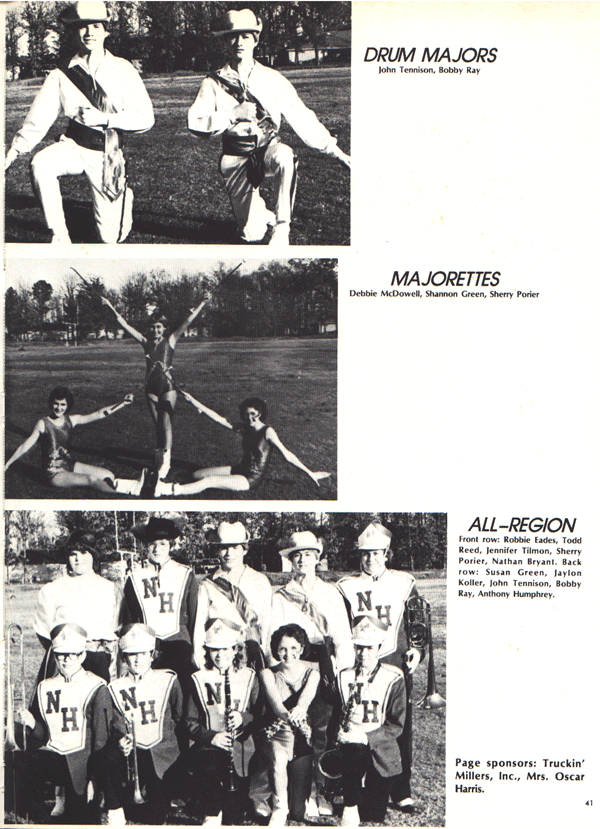
This picture is taken from the North Heights Junior High School Yearbook for 1982-83, page 41. Bobby Ray (the Co-Drum Major) and I were close friends and spent a good deal of time playing the piano for each other. Bobby had an upright piano that sounded great for Boogie Woogie.
The North Heights Junior High Marching Band in 1982-83
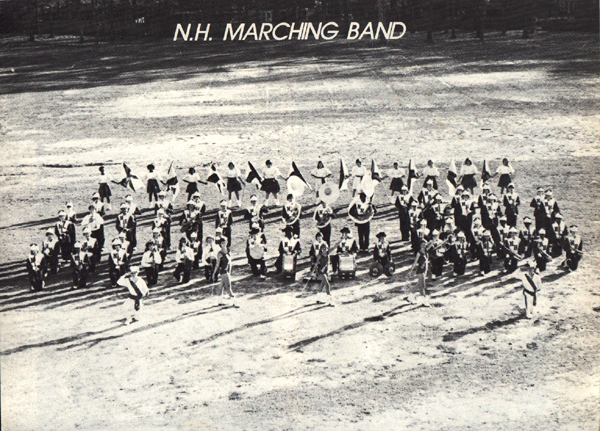
Drum majors Bobby Ray and I are in the foreground of the picture above. This photo was taken in the field behind North Heights Junior High School in Texarkana, Arkansas, in the fall of 1982. This photo appears in the 1982-83 North Heights Yearbook.
Arkansas High School Madrigals Choir in Texarkana, 1984-85 School Year
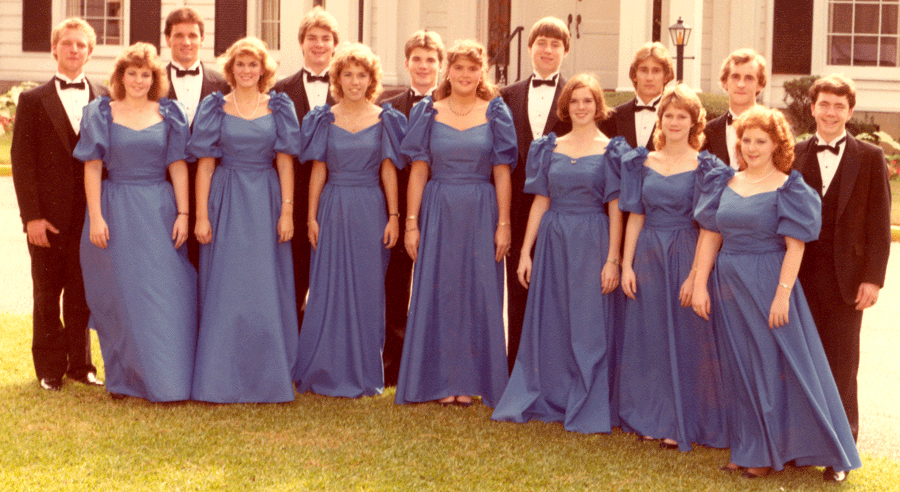
The above photo was taken at the Texarkana Country Club. On the far left is classically-trained pianist, and childhood Boogie Woogie collaborator, Michael Benson. I am fourth from the left. This photo was taken during my junior year of high school.
Musical Thrills at Arkansas High School in Texarkana, Arkansas
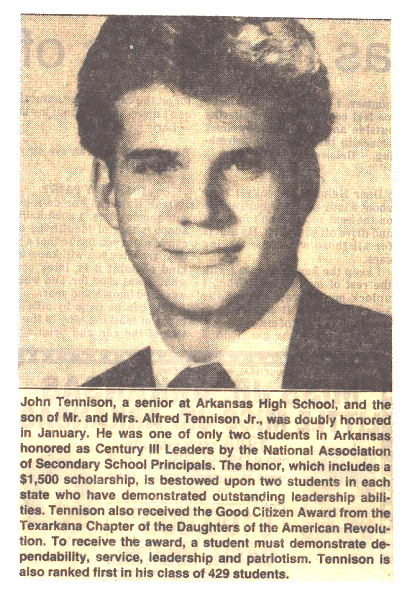
I can remember a football pep rally at Arkansas High School in the fall of 1985 during my senior year. I had been an exchange student to Japan the summer before, and had brought back my first keyboard based synthesizer, a Yamaha DX21. The band director at Arkansas High, George Gamble, had allowed me and some of the drummers from the band to perform "Axel F," the popular instrumental piece from the Eddie Murphy film, "Beverly Hills Cop." I played lead and bass on the keyboard, while the drummers played rhythm. During the performance of "Axel F," students ran down from the bleachers and began dancing on the gymnasium floor. The thrill I felt during this occurrence is hard to describe. I felt connected with the students dancing on the gym floor to a degree that I had never felt before. Their bodies were resonating to the sound that the drummers and I were making. The dancing students, the drummers, and I were "integrated." We were one! This moment was the most powerful experience of the "integrative" capacity of music that I had yet experienced. I was hooked. From then onward, I knew that I must somehow make music and its live performance forever part of my life. Up until this point, I had only "played" music. I had performed it competently, often with a positive response from an audience, but I had never felt at one with so many participants as I did on that day.
Nonjohn's College Years at Johns Hopkins in Baltimore
I continued to perform at various live events while I was an undergraduate psychology major at Johns Hopkins. Below is a photo of a performance on the Steps of Gilman Hall, the most well-known building on the Hopkins Homewood campus. I am the guy playing the keyboard (a Yamaha DX7, accompanied by a Yamaha RX-5 drum machine), along with two vocalists Mike Greenfield on Saxophone.
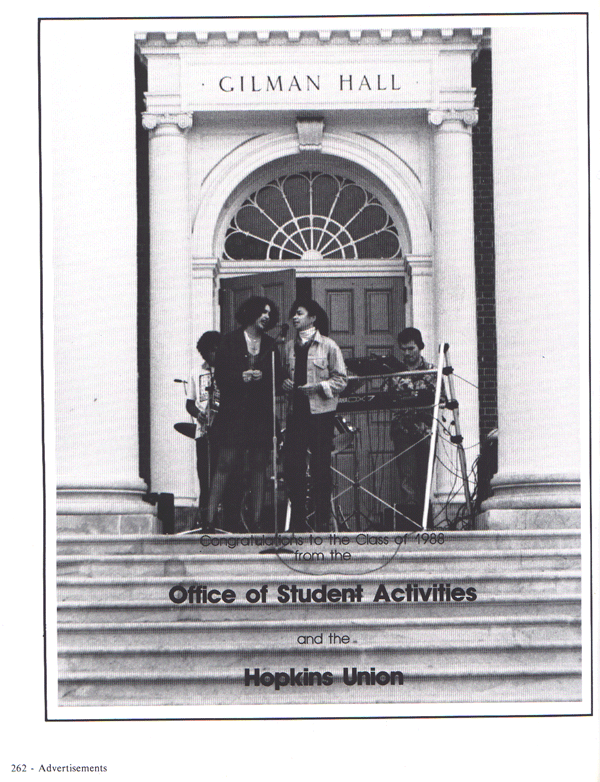
This image was taken from page 262 of the 1987-88 Johns Hopkins Yearbook. The Office of Student Activities and the Hopkins Student Union used this photo as their advertisement for the yearbook that year.
Nonjohn Blasts His Music at the ZBT Fraternity House on University Parkway in Baltimore
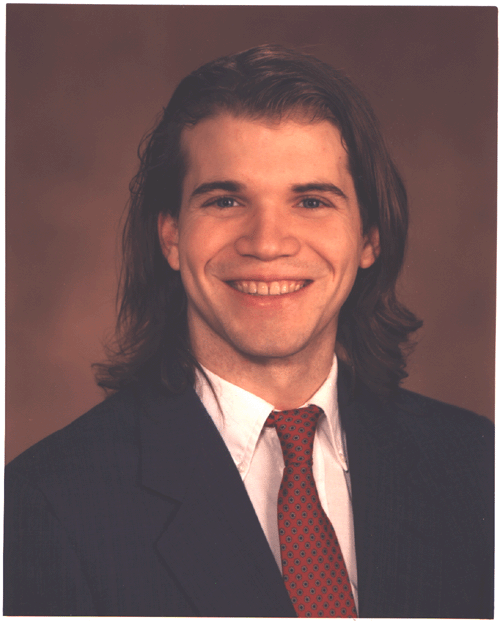
I joined the ZBT Fraternity during my last two years at Johns Hopkins. Pictured above is my fraternity photo. I had not grown my hair this long before going to college. Ultimately, I decided that it was easier to manage shorter hair! At the ZBT fraternity house, I developed a reputation for playing my music "too loud" while some of my more studious fraternity brothers were trying to study. The ZBT fraternity house was on University Parkway in Baltimore. I lived there during my last two years of college with my girlfriend, Patricia Kwon. My music studio was in my apartment, which was on the basement level of the fraternity house. Prior to dating me, Patricia had dated Gunther Anderson, the president of ZBT and a fine musician. Because of their support and tolerance of my LOUD music, I dedicated the first Nonjohn album to Patricia and Gunther. I also indebted to my ZBT brothers for helping with the production of the "Funk You" Concert, my first solo concert at Shriver Auditorium in Baltimore.
The Continuing Role of Boogie Woogie in My Life
Having grown up in Texarkana, I was easily exposed to sounds of Boogie Woogie since I was a child. Thus, I came by Boogie Woogie honestly. For me, Boogie Woogie came to be a sort of spiritual practice. I am indebted to musical pioneers from the Piney Woods of East Texas who created the Boogie Woogie style. Boogie Woogie began as a form of dance music and Boogie Woogie has always made me want to dance. Moreover, Boogie Woogie has come to be the musical style to which I move and meditate on a daily basis. For me, the Boogie Woogie sound is analogous to the "Om" mantra of Yogic practices. Boogie cuts to the core of my musical soul. When I play Boogie Woogie these days, I always get comments from observers about how much I move and wiggle around. Even though I might be sitting down, I experience myself as "dancing" as I play Boogie Woogie. Moreover, I don't believe my Boogie Woogie would sound as good or "swing" as well if I was expending mental energy to inhibit my body from moving. Such attempts would only divide my attention and make my playing less accurate. However, excessive movement can also create problems in accuracy of musical performance. (In terms of the relationship between movement and the quality of a musical performance, there seems to be an optimal amount of movement, beyond which the accuracy of note placement suffers.)
For a discussion of the history and continuing development of Boogie Woogie, see my article on Boogie Woogie.